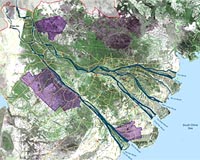| . |  |
. |
Beijing (AFP) Oct 26, 2010 The water level in China's Three Gorges Dam reached full capacity Tuesday for the first time since the world's biggest hydroelectric project began generating power in 2008, state media said. The amount of water in the dam's reservoir along the Yangtze river, China's longest, reached its design capacity of 175 metres (577 feet) early Tuesday morning, Cao Guangjing, project head told Xinhua news agency. Cao called the high water mark "a milestone in the construction of the gigantic reservoir," which will allow the dam to fulfill its flood control, power generation and navigational functions. Construction of the controversial 22.5 billion dollar dam began in 1993, but water storage in the 600-kilometre-long (372 mile) reservoir only started in 2003, the report said. In 2008 when the dam began to generate power, the water level in the reservoir had reached 172.8 metres. About 1.4 million people were displaced to make way for the dam project, the construction of which put several heritage sites deep underwater. Critics of the dam have long warned of environmental pollution and geological hazards along the massive reservoir. During the first six months of power generation, landslides and mudflows caused by rising and falling waters behind the dam forced the relocation of an additional 28,000 people, Xinhua said at the time. In August, the English-language China Daily reported that layers of trash and debris were building up in the reservoir, threatening to jam the massive dam. According to the Three Gorges Project Corporation, the dam currently operates 26 generators with a total designed capacity of 84.7 billion kilowatt-hours of electricity annually. Another six generators are under construction and expected to go into operation in 2012.
earlier related report The densely packed metropolis of seven million people faces a severe shortage of landfill space, with existing sites expected to reach saturation point early next year and limited options to dispose of refuse. Hong Kong residents each throw away 1.28 kilos (2.8 pounds) of waste daily, more than twice as much as Taiwan and South Korea, with only Singapore producing more waste per capita in the region, according to environmental group Friends of the Earth. The southern Chinese city also creates more rubbish than Norway, which topped a list of 30 economies surveyed by the Organisation for Economic Co-operation and Development (OECD) last year. Chung Shan-shan, a waste management expert at Baptist University, said Hong Kong lags behind when it comes to recycling and government waste-reduction measures. "In order for there to be an incentive for people to recycle, Hong Kong needs to implement a domestic waste charge, like there is in South Korea and Taiwan," she said. Details of a waste levy were expected to be released early next year. Hong Kong's government said that it has stepped up efforts to reduce waste with almost half the city's solid waste recycled. "The Government has devised a package of measures to tackle the imminent municipal solid waste problem through a three-pronged approach, covering waste reduction and recycling, incineration and land filling," it said in a statement. Pressure is mounting on Hong Kong officials to erect two more garbage incinerators in outlying areas, but environmentalists said that at least five should be built to handle Hong Kong's growing mountain of waste.
Share This Article With Planet Earth
Related Links Water News - Science, Technology and Politics
 Mekong countries should delay dam projects for decade: study
Mekong countries should delay dam projects for decade: studyPhnom Penh (AFP) Oct 15, 2010 Countries in the lower Mekong River region should delay any decisions about building hydropower dams for 10 years, an influential new study said Friday, warning of the many risks involved. The recommendation was made in a Strategic Environmental Assessment (SEA) report commissioned by the Mekong River Commission (MRC), an inter-governmental advisory body that deals with all Mekong River-rela ... read more |
|
| The content herein, unless otherwise known to be public domain, are Copyright 1995-2010 - SpaceDaily. AFP and UPI Wire Stories are copyright Agence France-Presse and United Press International. ESA Portal Reports are copyright European Space Agency. All NASA sourced material is public domain. Additional copyrights may apply in whole or part to other bona fide parties. Advertising does not imply endorsement,agreement or approval of any opinions, statements or information provided by SpaceDaily on any Web page published or hosted by SpaceDaily. Privacy Statement |